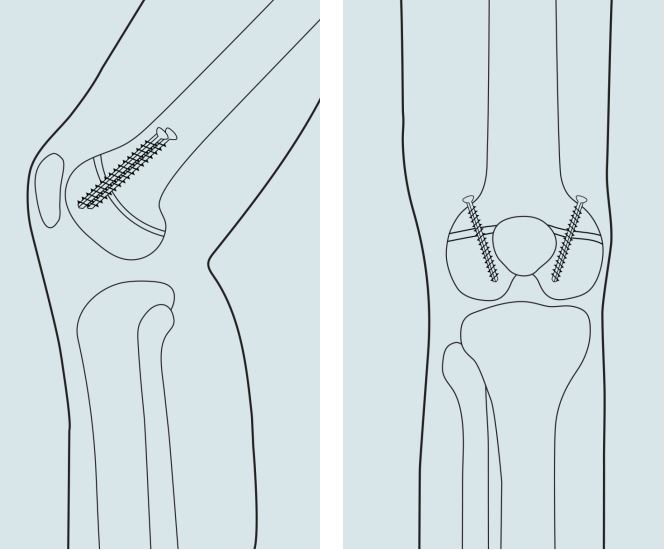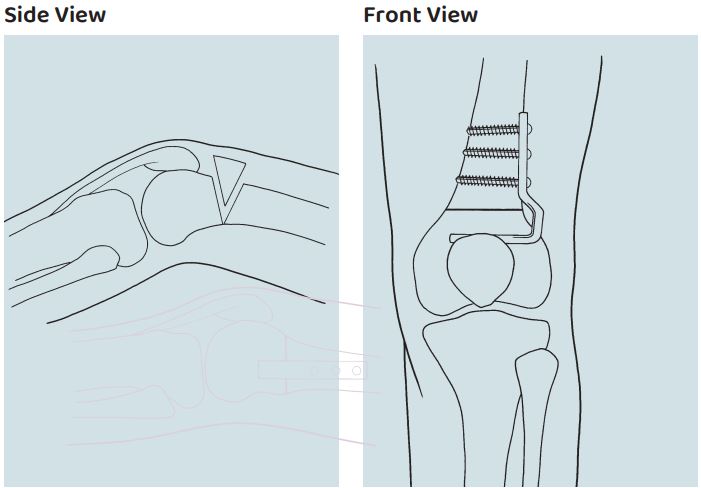What is joint malalignment?
Joint malalignment is an unusual bend (atypical angulation) in a joint. Joint malalignment may cause pain or difficulty performing everyday activities. It may also lead to wearing of the joint, pain, stiffness, and/or arthritis in the long term. A limb length discrepancy may accompany a joint malalignment.
What causes joint malalignment?
Joint malalignment can result from:
- Congenital (present from birth) disorders of the bones, muscles or joints.
- Disuse or overuse of the bones, muscles or joints caused by illness or disease.
- Diseases, such as bone cancer.
- Issues of the spine, shoulder or hip.
- Traumatic injuries, such as severe fractures that damage growth plates.
How is joint malalignment corrected with surgery?
Joint malalignment can be corrected by an orthopedic surgeon using one of the following methods:
In a child whose bones are expected to continue growing, the surgeon places an implant (plate and screws or screws) next to the growth plate. The implant temporarily slows growth on one side of the bone, allowing the opposite side to grow faster and gradually correct the deformity. Once the deformity is corrected, another surgery is performed to remove the implant. Alternatively, in a patient whose bones have limited growth remaining, a portion of the growth plate may be permanently stopped to achieve correction. This is known as permanent hemiepiphysiodesis.
Your physician will discuss which procedure is most appropriate for you and your child. Based on your child’s age and the malalignment that needs correction, your physician might prefer either a temporary or a permanent solution. For a successful correction, it’s important that
- The procedure is properly timed.
- The child receives follow-up care. If the plate is left in too long, it is possible for the leg to overcorrect. Overcorrection is easily avoided with regular follow-up to determine the timing of plate removal.

In a patient without any growth remaining, correction of a malalignment is performed with an osteotomy (cutting and reshaping of a bone) either acutely or gradually. An osteotomy with acute correction involves changing the alignment of a bone in the operating room to correct the angle. The correction is stabilized with an implant like plate and screws or a rod.
With gradual correction, the bone is separated in the operating room, and the correction is performed after the surgery with an external fixator over several weeks.
A limb length discrepancy may accompany a joint malalignment (Figure 4). Internal implants or an external fixator may be utilized to address the malalignment and length discrepancy.
The type of treatment strategy depends on the location and severity of the joint malalignment and if a limb length discrepancy is present.

What can we expect after joint malalignment surgery?
To help healing and lessen your child’s discomfort, you should:
- Elevate your child’s knee and ankle above the level of the heart and apply ice. Do this for a week after surgery to help decrease swelling.
- Have your child use crutches or a walker and maintain weightbearing precautions as required based on the individual surgery.
- Give your child assistance, if necessary, to go up and down stairs.
Typically, patients are allowed to weight bear as tolerated after a hemiepiphysiodesis surgery. Usually, soft dressings are utilized, and braces and casts are not necessary.
After an osteotomy with acute correction, patients are usually restricted in weightbearing with either a brace or a cast for four to six weeks, depending on the type of correction.
After having surgery involving an implant, the child might feel the implant under the skin. The discomfort is typically mild and resolves with removal of the implant.
After an osteotomy with gradual correction, the external fixator is gradually adjusted over several weeks to achieve correction. Once the correction is complete and the bone is healed, the external fixator is removed with another surgery.
What should we watch out for after joint malalignment surgery?
Notify your physician for increasing pain, increasing swelling, wound redness and drainage, fevers higher than 101.5 degrees Fahrenheit, and numbness/tingling.
This information is for educational purposes only. It is not intended to replace the advice of your health care providers. If you have any questions, talk with your doctor or others on your health care team.
If you are a Gillette patient with urgent questions or concerns, please contact Telehealth Nursing at 651-229-3890.
 Home Page
Home Page


